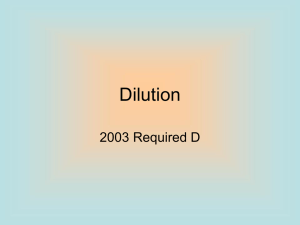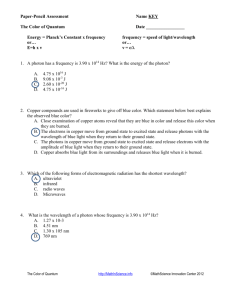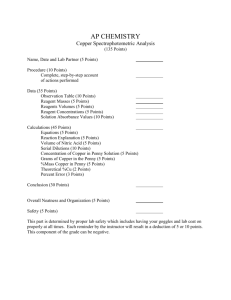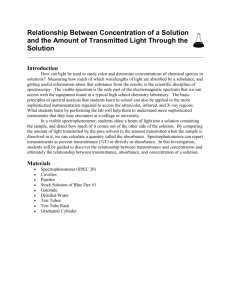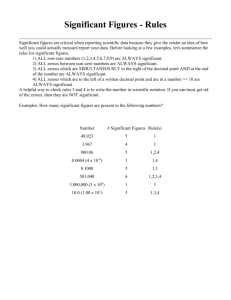AP Chemistry Lab 4 Using Beer's Law to Determine the Mass
advertisement
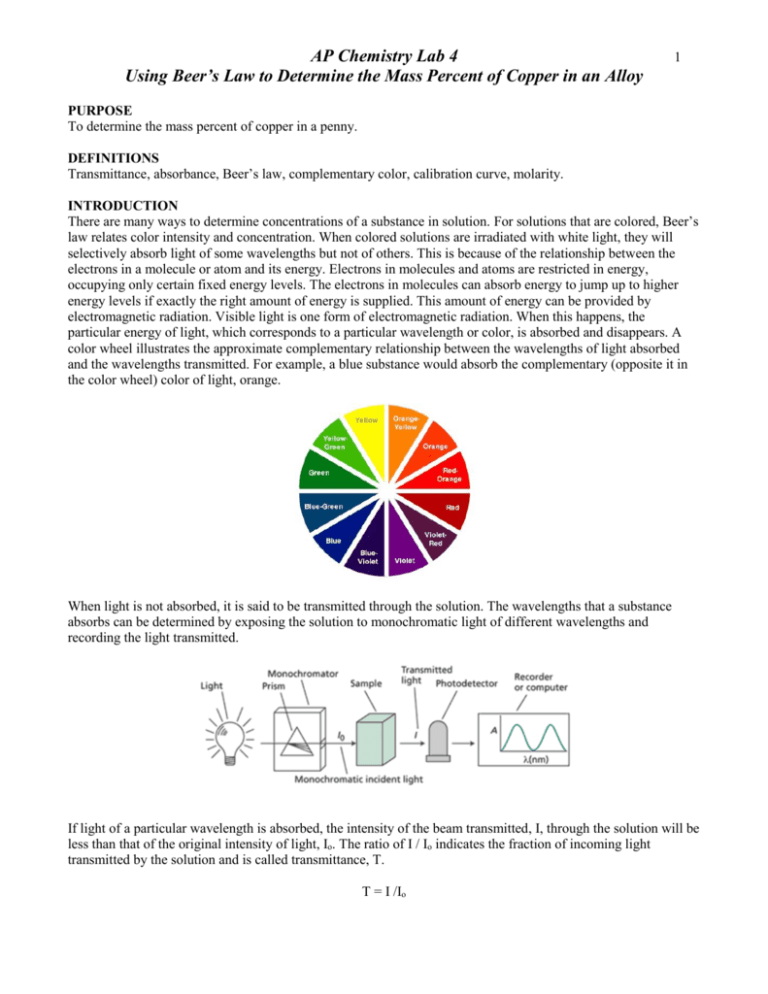
AP Chemistry Lab 4 Using Beer’s Law to Determine the Mass Percent of Copper in an Alloy 1 PURPOSE To determine the mass percent of copper in a penny. DEFINITIONS Transmittance, absorbance, Beer’s law, complementary color, calibration curve, molarity. INTRODUCTION There are many ways to determine concentrations of a substance in solution. For solutions that are colored, Beer’s law relates color intensity and concentration. When colored solutions are irradiated with white light, they will selectively absorb light of some wavelengths but not of others. This is because of the relationship between the electrons in a molecule or atom and its energy. Electrons in molecules and atoms are restricted in energy, occupying only certain fixed energy levels. The electrons in molecules can absorb energy to jump up to higher energy levels if exactly the right amount of energy is supplied. This amount of energy can be provided by electromagnetic radiation. Visible light is one form of electromagnetic radiation. When this happens, the particular energy of light, which corresponds to a particular wavelength or color, is absorbed and disappears. A color wheel illustrates the approximate complementary relationship between the wavelengths of light absorbed and the wavelengths transmitted. For example, a blue substance would absorb the complementary (opposite it in the color wheel) color of light, orange. When light is not absorbed, it is said to be transmitted through the solution. The wavelengths that a substance absorbs can be determined by exposing the solution to monochromatic light of different wavelengths and recording the light transmitted. If light of a particular wavelength is absorbed, the intensity of the beam transmitted, I, through the solution will be less than that of the original intensity of light, Io. The ratio of I / Io indicates the fraction of incoming light transmitted by the solution and is called transmittance, T. T = I /Io AP Chemistry Lab 4 Using Beer’s Law to Determine the Mass Percent of Copper in an Alloy 2 A more useful quantity is related to the amount of light absorbed, called absorbance, A. A = –log(T) The higher the absorbance of light by a solution, the lower the transmittance. The wavelength () at which absorbance is highest is the wavelength to which the solution is most sensitive to concentration changes. This wavelength is called λmax. In the first part of this experiment, you will determine λmax of a standard copper(II) ion solution. Once λmax is determined, you will construct a calibration curve based on Beer’s law: A=abc where a = molar absorptivity (often symbolized by ε), which depends on the substance, the solvent and wavelength, λ. b = pathlength of the light through the solution (also called the cell length), usually 1.00 cm c = molar concentration the The molar absorptivity, a, depends on the substance, the solvent, and wavelength, λ. The units for molar absorptivity are 1/M·cm or L/mole·cm. Beer’s Law is useful because the absorbance is directly proportional to concentration provided the absorbing substance, solvent, wavelength, and pathlengh are fixed. With this equation you can determine the concentration of a substance. It should be noted that there are conditions where deviations from Beer’s law occur. This happens when the concentration of the absorbing substance is too high to allow significant light to be transmitted or because of lack of sensitivity of instrumentation. In this lab, you will study the light absorption of aqueous copper(II) ions. Copper(II) ions in water form a complex ion with the formula Cu(H2O)6)2+ which are blue in appearance. PROCEDURE Spectral Curve 1. Your instructor will show you the correct use of a spectrophotometer. Each model is slightly different in the way solutions are measured. 2. Measure the transmittance of the standard 0.40 M copper solution every 20 nanometers from 400–660 nm. Record your data in a table. (Note: some spectrophotometers display percent transmittance rather than transmittance. Record only transmittance.) Calibration Curve Solutions 3. Clean and dry five large test tubes. 4. Determine what volume of 0.400 M Cu2+ solution (the stock solution) is required to make 20.00 mL of 0.200 M Cu2+ solution. Use a volumetric pipette to transfer this volume of the stock solution into a clean test tube. Then add the proper amount of distilled water to the test tube using a separate pipette to make a total volume of 20.00 mL. Thoroughly mix the solution. Repeat the dilution process to make 20.00 mL each of three additional dilute solutions that are 0.100 M, 0.0500 M, and 0.0250 M, respectively. Use the process of serial dilution, whereby each diluted solution acts as the starting solution for the next dilution. Be sure to “rinse” the pipette each time with ~2 mL of solution before withdrawing that solution for the next dilution. 5. Seal these five solutions with Parafilm to measure transmittance in the next lab period. AP Chemistry Lab 4 Using Beer’s Law to Determine the Mass Percent of Copper in an Alloy 3 Measuring the Unknown 6. Measure the mass of five post-1983 penny to ± 0.0001 g using the analytical balance. Place the pennies in a clean 400 mL beaker. 7. Assuming the penny is 100% copper (it is not!), use stoichiometry to determine the amount of 16 M nitric acid to add to the penny to completely convert the copper metal to copper(II) ion. The half reactions for this redox reaction are: unbalanced oxidation half-reaction: unbalanced reduction half-reaction: Cu(s) ➝ Cu2+(aq–) NO3–(aq) ➝ NO(g) You will need to write the balanced equation for the overall reaction to do the stoichiometric calculation. Show this equation and stoichiometric calculation in your lab report. 8. Under a fume hood, have your teacher add approximately 2 mL more than this volume of HNO3(aq) to the pennies so that the HNO3 is the excess reagent, and then your teacher will cover the beaker with a watch glass. Wait a few minutes for the reaction to proceed. Record observations. If the copper in the penny is not completely dissolved, the teacher will add more nitric acid. After the metal dissolves completely, your teacher will add distilled water to bring the volume to ~75 mL. Then you will remove the beaker from the fume hood and transfer the solution to a 100 mL volumetric flask. (Caution: this solution still contains HNO3.)Rinse the beaker three times with ~5 mL of distilled water and add the washings to the flask. Dilute to a final volume of 100.00 mL, cover with Parafilm, and mix thoroughly. 9. Measure the transmittance of this copper(II) ion solution using the spectrophotometer set at the predetermined wavelength. 10. Measure the transmittance of each of the five calibration curve solutions. ANALYSIS Spectral Curve 1. Calculate the absorbance for each measured transmittance. 2. Construct a plot of absorbance vs. wavelength, and determine the wavelength where the absorbance equals ~1.0. (This will ensure that the wavelength chosen for the remainder of the lab will be done in the linear range of the spectrophotometer.) 3. Use the absorbance value at the determined wavelength to calculate the molar absorptivity of the hydrated copper(II) ion. For this calculation, assume the path length is 1.00 cm. Calibration Curve 4. Convert transmittance of each of the five calibration solutions to absorbance, and construct a plot of absorbance vs. concentration. 5. Determine the equation for the line of best fit. Measuring the Unknown 6. Use the equation of the best fit line from the calibration curve to calculate the concentration of copper(II) ion in the penny solution. 7. Determine the mass of Cu dissolved in the penny solution based upon the determined molarity and volume of the volumetric flask. 8. Use this mass to calculate the mass percent copper in the penny. 9. Compare the mass percent values of copper in the penny determined by the two different experimental methods (Lab 1 and Lab 4). Which method do you think is more accurate? Why? EXPERIMENTAL ERROR What would be the effect on the value of percent copper in the penny if the penny contained a colored impurity?


